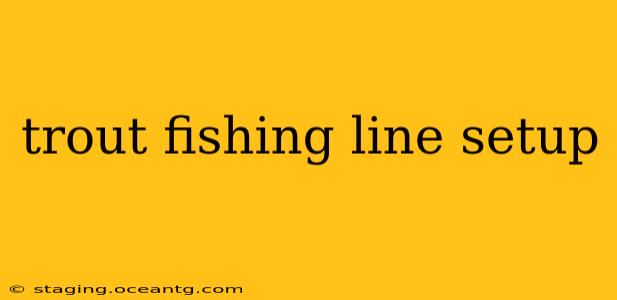Trout fishing demands a delicate touch and precise technique. Choosing the right line and setting it up correctly is crucial for success. This guide dives deep into the intricacies of trout fishing line setup, covering everything from line type and weight to leader selection and knot tying. We'll also address common questions anglers have about their trout fishing line setup.
What type of fishing line is best for trout?
The best fishing line for trout depends heavily on the fishing conditions and your preferred fishing style. However, several types consistently prove effective:
-
Fluorocarbon: Known for its low visibility underwater, high abrasion resistance, and sensitivity, fluorocarbon is a top choice for trout fishing, particularly in clear water. Its stiffness helps prevent line sag, improving presentation.
-
Nylon Monofilament: A classic and reliable option, monofilament is more forgiving than fluorocarbon, making it ideal for beginners or anglers fishing in areas with snags. It’s generally more affordable too.
-
Braided Line: While less common for trout fishing than mono or fluorocarbon, braided line offers incredible sensitivity and strength. It's best used with a fluorocarbon leader to maintain stealth. Its lack of stretch can be advantageous in detecting subtle bites, but it's crucial to use a sensitive rod to offset its stiffness.
What weight line should I use for trout?
Line weight for trout fishing is usually between 2 and 6-pound test. Lighter lines are preferred in clear water and for smaller trout, while heavier lines might be necessary in faster currents or when targeting larger fish or those in more heavily vegetated areas. The specific weight will depend on factors like water clarity, current strength, and the size of the trout you are targeting.
How long should my trout fishing leader be?
Leader length is a critical aspect of your trout fishing setup. A longer leader, typically ranging from 3 to 8 feet, is often preferred because it provides a more natural presentation of your lure or bait. This allows for a more subtle approach and increases the likelihood of a successful strike. However, shorter leaders can be advantageous in heavily-vegetated areas or in strong currents. The optimal length depends heavily on the specific fishing conditions and the style of fishing you're employing.
What kind of knots should I use for trout fishing?
Knot strength and security are vital in trout fishing, as a broken line can mean losing a prized catch. Several reliable knots are commonly used:
- Improved Clinch Knot: A versatile and strong knot, ideal for connecting your line to lures and hooks.
- Blood Knot: Used to join two lines of similar diameter, essential when connecting your main line to your leader.
- Uni Knot: Another strong knot, effective for tying lures and flies.
Practice these knots thoroughly before heading out to ensure you can tie them quickly and efficiently under pressure.
What is the best setup for nymph fishing for trout?
Nymph fishing often involves a heavier line and a relatively short leader (2-4 feet) to effectively present your nymph at the desired depth in the water column. The length of your leader is important for controlling the nymph's drift. A weighted nymph may also be used. A sensitive rod is essential for detecting strikes.
How do I set up my spinning reel for trout fishing?
Spinning reel setup for trout involves choosing the correct line weight, properly spooling your reel, and ensuring the drag is appropriately adjusted. Overfilling the reel can cause issues, so leaving enough space at the top of the spool is essential. The drag should be set to allow the line to slip during a strong run, preventing breakages, but still offer enough resistance to fight the fish.
What are the different types of trout fishing lures?
The best lures vary with the type of trout and the specific conditions. Many options exist, including:
- Spoons: Effective for attracting trout with their flashing action.
- Spinners: Similar to spoons in their appeal to trout.
- Crankbaits: Useful for covering water and targeting fish in various depths.
- Soft plastics: Lifelike imitations of small baitfish.
Selecting the appropriate lure for the specific situation is crucial for successful trout fishing. Consider factors like water clarity, depth, and the type of trout you’re targeting when making your choice.
Remember, mastering your trout fishing line setup is an iterative process. Experiment with different line types, weights, and leaders to find what works best for you in various conditions. Consistent practice with your knots will also increase your confidence and success rate.
